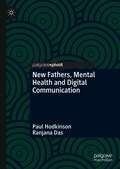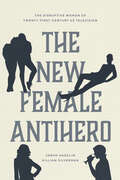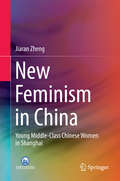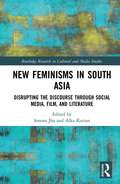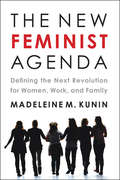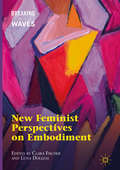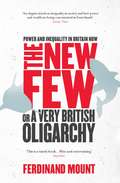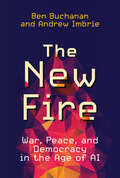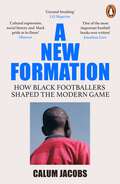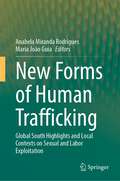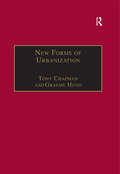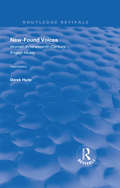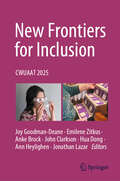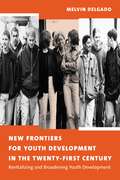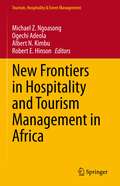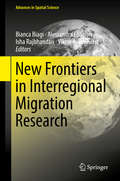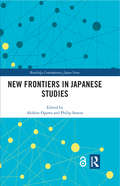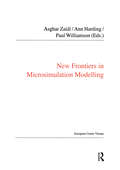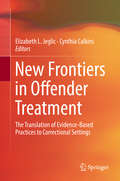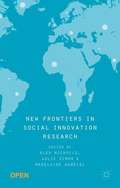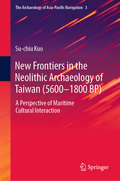- Table View
- List View
New Fathers, Mental Health and Digital Communication
by Paul Hodkinson Ranjana DasThis book explores the experiences of new fathers struggling with mental health difficulties and focuses on the role of digital media as part of their approaches to coping. Hodkinson and Das show how the ways new fathers are positioned by society can make it hard for them to recognize their struggles as legitimate, or reach out for help. The book explores a range of different uses of digital communication by struggling fathers, from selective forms of disconnection, to the seeking out of online information or support. The authors highlight the significance even of the smallest digital acts as part of coping journeys and outline the development of tentative or hidden attempts to reach out for help, and the potential for supportive digital interactions to emerge. The book’s conclusions highlight the agentic possibilities digital media might offer for struggling new fathers, while emphasizing the need for improvements in how they are prepared and supported by health services and others.
The New Female Antihero: The Disruptive Women of Twenty-First-Century US Television
by Sarah Hagelin Gillian SilvermanThe New Female Antihero examines the hard-edged spies, ruthless queens, and entitled slackers of twenty-first-century television. The last ten years have seen a shift in television storytelling toward increasingly complex storylines and characters. In this study, Sarah Hagelin and Gillian Silverman zoom in on a key figure in this transformation: the archetype of the female antihero. Far from the sunny, sincere, plucky persona once demanded of female characters, the new female antihero is often selfish and deeply unlikeable. In this entertaining and insightful study, Hagelin and Silverman explore the meanings of this profound change in the role of women characters. In the dramas of the new millennium, they show, the female antihero is ambitious, conniving, even murderous; in comedies, she is self-centered, self-sabotaging, and anti-aspirational. Across genres, these female protagonists eschew the part of good girl or role model. In their rejection of social responsibility, female antiheroes thus represent a more profound threat to the status quo than do their male counterparts. From the devious schemers of Game of Thrones, The Americans, Scandal, and Homeland, to the joyful failures of Girls, Broad City, Insecure, and SMILF, female antiheroes register a deep ambivalence about the promises of liberal feminism. They push back against the myth of the modern-day super-woman—she who “has it all”—and in so doing, they give us new ways of imagining women’s lives in contemporary America.
The New Female Antihero: The Disruptive Women of Twenty-First-Century US Television
by Sarah Hagelin Gillian SilvermanThe New Female Antihero examines the hard-edged spies, ruthless queens, and entitled slackers of twenty-first-century television. The last ten years have seen a shift in television storytelling toward increasingly complex storylines and characters. In this study, Sarah Hagelin and Gillian Silverman zoom in on a key figure in this transformation: the archetype of the female antihero. Far from the sunny, sincere, plucky persona once demanded of female characters, the new female antihero is often selfish and deeply unlikeable. In this entertaining and insightful study, Hagelin and Silverman explore the meanings of this profound change in the role of women characters. In the dramas of the new millennium, they show, the female antihero is ambitious, conniving, even murderous; in comedies, she is self-centered, self-sabotaging, and anti-aspirational. Across genres, these female protagonists eschew the part of good girl or role model. In their rejection of social responsibility, female antiheroes thus represent a more profound threat to the status quo than do their male counterparts. From the devious schemers of Game of Thrones, The Americans, Scandal, and Homeland, to the joyful failures of Girls, Broad City, Insecure, and SMILF, female antiheroes register a deep ambivalence about the promises of liberal feminism. They push back against the myth of the modern-day super-woman—she who “has it all”—and in so doing, they give us new ways of imagining women’s lives in contemporary America.
The New Female Antihero: The Disruptive Women of Twenty-First-Century US Television
by Sarah Hagelin Gillian SilvermanThe New Female Antihero examines the hard-edged spies, ruthless queens, and entitled slackers of twenty-first-century television. The last ten years have seen a shift in television storytelling toward increasingly complex storylines and characters. In this study, Sarah Hagelin and Gillian Silverman zoom in on a key figure in this transformation: the archetype of the female antihero. Far from the sunny, sincere, plucky persona once demanded of female characters, the new female antihero is often selfish and deeply unlikeable. In this entertaining and insightful study, Hagelin and Silverman explore the meanings of this profound change in the role of women characters. In the dramas of the new millennium, they show, the female antihero is ambitious, conniving, even murderous; in comedies, she is self-centered, self-sabotaging, and anti-aspirational. Across genres, these female protagonists eschew the part of good girl or role model. In their rejection of social responsibility, female antiheroes thus represent a more profound threat to the status quo than do their male counterparts. From the devious schemers of Game of Thrones, The Americans, Scandal, and Homeland, to the joyful failures of Girls, Broad City, Insecure, and SMILF, female antiheroes register a deep ambivalence about the promises of liberal feminism. They push back against the myth of the modern-day super-woman—she who “has it all”—and in so doing, they give us new ways of imagining women’s lives in contemporary America.
New Femininities
by Rosalind Gill Christina ScharffThis collection of original essays looks at the way in which experiences and representations of femininity are changing, and explores the possibilities for producing 'new' femininities in the twenty-first century. The volume includes a Preface by leading feminist scholar Angela McRobbie.
New Feminism in China
by Jiaran ZhengThis book is based on rich empirical data and findingsconcerning the lives, perceptions and ambitions of young middle-class femalegraduates, thus providing essential insights into the lives and viewpoints of apreviously unresearched group in China from a feminist scholarly perspective. The study shows how the lives of young women and debates over youthfulfemininity lie at the very heart of modern Chinese history and society. With acentral focus on women's issues, the book's ultimate goal is to enable Westernreaders to better understand the changing ideologies and the overall socialdomain of China under the leadership of President Xi. The empirical datapresented includes interviews and group discussions, as well as illustrations,tables and images collected during a prolonged period of fieldwork. Theinsights shared here will facilitate cross-cultural communication with bothWestern feminist academics and readers who are sensitive to different cultures.
New Feminisms in South Asian Social Media, Film, and Literature: Disrupting the Discourse (Routledge Research in Cultural and Media Studies)
by Sonora Jha Alka KurianThis book is a study of the resurgence and re-imagination of feminist discourse on gender and sexuality in South Asia as told through its cinematic, literary, and social media narratives. It brings incisive and expert analyses of emerging disruptive articulations that represent an unprecedented surge of feminist response to the culture of sexual violence in South Asia. Here scholars across disciplines and international borders chronicle the expressions of a disruptive feminist solidarity in contemporary South Asia. They offer critical investigations of these newly complicated discourses across narrative forms – hashtag activism on Facebook and Twitter, the writings of diasporic writers such as Jhumpa Lahiri, Bollywood films like Mardaani, feminist Dalit narratives in the fiction of Bama Faustina, social media activism against rape culture, journalistic and cinematic articulations on queer rights, state censorship of "India’s Daughter", and feminist film activism in Bangladesh, Kashmir, Nepal, and Sri Lanka.
The New Feminist Agenda: Defining the Next Revolution for Women, Work, and Family
by Madeleine M. KuninFeminists opened up thousands of doors in the 1960s and 1970s, but decades later, are U.S. women where they thought they would be? The answer, it turns out, is a resounding no. Surely there have been gains. Women now comprise nearly 60 percent of college undergraduates and half of all medical and law students. They have entered the workforce in record numbers, making the two wage earner family the norm. But combining a career and family turned out to be more complicated than expected. While women changed, social structures surrounding work and family remained static. Affordable and high quality child care, paid family leave, and equal pay for equal work remain elusive for the vast majority of working women. In fact, the nation has fallen far behind other parts of the world on the gender equity front. We lag behind more than seventy countries when it comes to the percentage of women holding elected federal offices. Only 17 percent of corporate boards include women members. And just 5 percent of Fortune 500 companies are led by women. It is time, says the author, to change all that. Looking back over five decades of advocacy, she analyzes where progress stalled, looks at the successes of other countries, and charts the course for the next feminist revolution, one that mobilizes women, and men, to call for the kind of government and workplace policies that can improve the lives of women and strengthen their families.
New Feminist Perspectives on Embodiment (Breaking Feminist Waves)
by Luna Dolezal Clara FischerDespite several decades of feminist activism and scholarship, women’s bodies continue to be sites of control and contention both materially and symbolically. Issues such as reproductive technologies, sexual violence, objectification, motherhood, and sex trafficking, among others, constitute ongoing, pressing concerns for women’s bodies in our contemporary milieu, arguably exacerbated in a neoliberal world where bodies are instrumentalized as sites of human capital. This book engages with these themes by building on the strong tradition of feminist thought focused on women’s bodies, and by making novel contributions that reflect feminists’ concerns—both theoretically and empirically—about gender and embodiment in the present context and beyond. The collection brings together essays from a variety of feminist scholars who deploy diverse theoretical approaches, including phenomenology, pragmatism, and new materialisms, in order to examine philosophically the question of the current status of gendered bodies through cutting-edge feminist theory.
New Feminist Stories of Child Sexual Abuse: Sexual Scripts and Dangerous Dialogue
by Sam Warner Paula ReaveyThe international feminist contributors to this book look through the lens of poststructuralism at how child sexual abuse is differently represented and understood in the populist, academic, clinical, media and legal contexts. Reworking earlier feminist analyses, they show how child sexual abuse is not just about gender and power but also about class, race and sexuality. The first, theoretical section of the book critiques normative theories of the 'effects' of abuse, explores the impact and consequences of feminist interventions and critically examines the potential usefulness of a feminist post-stucturalist approach. In the second part, these understandings are applied to specific arenas of practice with the aim of providing a framework for critical intervention and alternative and better ways of working with child sexual abuse.
The New Few: Or a Very British Oligarchy
by Ferdinand MountBankers' bonuses keep rising, corporate profits are breaking records, and politicians are constantly mired in scandal. Is Britain now being run by a small, powerful group of oligarchs? This was supposed to be the era when democracy came into its own, but instead power and wealth in Britain have slowly been consolidated in the hands of a small elite, while the rest of the country struggles financially and switches off politically. We are now ruled by a gang of fat-cats with fingers in every pie who squabble for power among themselves while growing richer. Bored with watching corrupt politicians jockeying for power, ordinary Britons are feeling disconnected from politics and increasingly cynical about the back-scratching relationship between politicians and big business. The New Few shows us what has led to this point, and asks the critical questions: why has Britain become a more unequal society over the past thirty years? Why have the banks been bailed out with taxpayers' money, while bankers are still receiving huge bonuses? Why have those responsible not been held accountable for the financial crash? Why has power in Britain become so concentrated in the hands of corrupt politicians who have been exposed cheating their constituents in the expenses scandal? Despite this bleak diagnosis, there are solutions to the rise of the new ruling class in the modern West. The New Few sets out some of the ways in which we can restore our democracy, bringing back real accountability to British business and fairness to our society.
The New Fire: War, Peace, and Democracy in the Age of AI
by Ben Buchanan Andrew ImbrieAI is revolutionizing the world. Here&’s how democracies can come out on top.Artificial intelligence is revolutionizing the modern world. It is ubiquitous—in our homes and offices, in the present and most certainly in the future. Today, we encounter AI as our distant ancestors once encountered fire. If we manage AI well, it will become a force for good, lighting the way to many transformative inventions. If we deploy it thoughtlessly, it will advance beyond our control. If we wield it for destruction, it will fan the flames of a new kind of war, one that holds democracy in the balance. As AI policy experts Ben Buchanan and Andrew Imbrie show in The New Fire, few choices are more urgent—or more fascinating—than how we harness this technology and for what purpose. The new fire has three sparks: data, algorithms, and computing power. These components fuel viral disinformation campaigns, new hacking tools, and military weapons that once seemed like science fiction. To autocrats, AI offers the prospect of centralized control at home and asymmetric advantages in combat. It is easy to assume that democracies, bound by ethical constraints and disjointed in their approach, will be unable to keep up. But such a dystopia is hardly preordained. Combining an incisive understanding of technology with shrewd geopolitical analysis, Buchanan and Imbrie show how AI can work for democracy. With the right approach, technology need not favor tyranny.
A New Formation: How Black Footballers Shaped the Modern Game
by Calum JacobsA New Formation is an inventive and highly original analysis of the contributions that Black British footballers have made to Black British culture.Calum Jacobs and his co-contributors - including authors Musa Okwonga and Aniefiok Ekpoudom and sports broadcaster Jeanette Kwakye - eschew the standard frameworks of trauma and oppression that are foisted upon Black narratives. Instead, they draw upon broader social and cultural history to examine Black footballers in contexts larger than themselves. By engaging with the subtle connections between football and Black cultural expression, A New Formation reveals the vibrancy and nuance of contemporary Black life in Britain.Featuring interviews with Andy Cole, Ian Wright and Anita Asante.
New Forms of Human Trafficking: Global South Highlights and Local Contexts on Sexual and Labor Exploitation
by Anabela Miranda Rodrigues Maria João GuiaThis book analyses new forms of human trafficking taking into account the transposition of the Directive 2011/36/UE which sets out minimum standards to be applied throughout the European Union in preventing and combating trafficking in human beings and protecting its victims. Sexual exploitation of trafficked persons is at its highest rate. After COVID-19, new forms of sexual exploitation have been identified, specifically in the Global South. The book analyses new forms of exploitation used by traffickers to coerce victims. Combining the perspectives of academic researchers with those of highly skilled professionals from governmental institutions, this book is a unique contribution, promoting collaboration in preventing and combating human trafficking crime, and in raising awareness of this ongoing problem.
New Forms of Urbanization: Beyond the Urban-Rural Dichotomy
by Graeme HugoThere is increasing appreciation in the social sciences that context is an important element in understanding social, economic, cultural, political and demographic processes. An important element in context is the type of settlement in which people live and work and so, it is vital to be able to categorise people into particular settlements types. This book brings together a leading team of social scientists to present the latest information on urbanization around the world, highlighting examples of development patterns that are not adequately captured by the UN's type of reporting systems and drawing attention to other ways of representing current trends.
New-found Voices: Women in Nineteenth-century English Music (Routledge Revivals)
by Derek HydeFirst published in 1998, this volume by Derek Hyde remedies the lack of information concerning the contribution made by women to musical life in Britain during the nineteenth century in this carefully researched survey. The book reveals the significant role played by women in the production and performance of certain genres of music, such as piano music, songs and ballads, and touches on the reasons why they were more prominent in these areas than in the male preserves of chamber and orchestral music. In particular, the pioneering work of Sarah Glover in Sol-fa notation and the part played by Mary Wakefield in establishing the Competitive Festival Movement are charted. The third edition includes a new introduction, taking into account recent research in the field of gender and music. There is also a revised chapter on the work of Ethel Smyth, the first woman composer to enjoy a measure of success in England. This book will be of interest to social historians, musicologists and those concerned with women’s history alike.
New Frontiers for Inclusion: CWUAAT 2025
by Joy Goodman-Deane Emilene Zitkus Anke Brock John Clarkson Hua Dong Ann Heylighen Jonathan LazarThis book presents papers from the 12th Cambridge Workshop on Universal Access and Assistive Technology (CWUAAT 2025), to be held in April 2025. This workshop series has hosted the multifaceted dialogue on design for inclusion since 2002, involving disciplines including design, computer science, engineering, architecture, ergonomics and human factors, policy and gerontology. The conference theme for 2025 is New frontiers for inclusion. The major themes dealt with in this collection include: Understanding people Designing for an ageing population Designing for particular needs Designing inclusive environments New challenges and opportunities the possibilities and challenges for inclusive design offered by AI and other emerging technologies. With its thematic wealth, this proceedings provides a unique insight into the current national and international research in the fields of inclusive design, universal access, and assistive and rehabilitative technology.
New Frontiers for Youth Development in the Twenty-First Century: Revitalizing and Broadening Youth Development
by Melvin DelgadoPractical guide and theoretical manifesto, New Frontiers for Youth Development is a vital roadmap to the problems and prospects of youth development programs today and in the future.In response to an unprecedented array of challenges, policy makers and care providers in the field of youth dvevelopment have begun to expand the field both practically and conceptually. This expansion has thus far outstripped comprehensive analysis of the issues it raises, among them the important matter of establishing common standards of legitimacy and competence for practitioners. New Frontiers for Youth Development is an overview of the field designed to foster a better understanding of the multifaceted aspects and inherent tensions of youth development.Melvin Delgado outlines the broad social forces that affect youth, particularly at-risk or marginalized youth, and the programs designed to address their needs. He stresses the importance of a contextualized approach that avoids rigid standardization and is attuned to the many factors that shape a child's development: cognitive, emotional, physical, moral, social, and spiritual. The key characteristic of youth development in the twenty-first century, Delgado suggests, is the participation of young people as practitioners themselves. Youth must be seen as assets as well as clients, incorporated into the educational process in ways that build character, maturity, and self-confidence.
New Frontiers in Hospitality and Tourism Management in Africa (Tourism, Hospitality & Event Management)
by Michael Z. Ngoasong Ogechi Adeola Albert N. Kimbu Robert E. HinsonThis book provides a management perspective on the full historical, contemporary, and geographic landscape of hospitality and tourism (H&T) in Africa. In so doing, it critically assesses and challenges the applicability of Western theories within the African context and draws attention to the insights offered by African management concepts. A variety of key topics are examined, including, for example, H&T management practices and management innovation in Africa, the drivers of and variation in uptake of Western management practices, policies and strategies to promote the development of H&T organizations, the influence of management practices on the competitiveness of African countries as tourism destinations, and areas for improvement of H&T organizations in Africa in the digital age. The approach is multidisciplinary. Both local and global perspectives are presented by authors from Africa, Europe, North America, and Asia, with inclusion of intra- and inter-country comparisons. This book will be essential reading for scholars, students, businesses, and policy makers with an interest in H&T in Africa.
New Frontiers in Interregional Migration Research (Advances in Spatial Science)
by Viktor A. Venhorst Isha Rajbhandari Alessandra Faggian Bianca BiagiThis book focuses on the latest advances and challenges in interregional migration research. Given the increase in the availability of "big data" at a finer spatial scale, the book discusses the resulting new challenges for researchers in interregional migration, especially for regional scientists, and the theoretical and empirical advances that have been made possible. In presenting these findings, it also sheds light on the different migration drivers and patterns in the developed and developing world by comparing different regions around the globe. The book updates and revisits the main academic debates in interregional migration, and presents new emerging lines of investigation and a forward-looking research agenda.
New Frontiers in Japanese Studies (Routledge Contemporary Japan Series)
by Akihiro Ogawa Philip SeatonOver the last 70 years, Japanese Studies scholarship has gone through several dominant paradigms, from ‘demystifying the Japanese’, to analysis of Japanese economic strength, to discussion of global interest in Japanese popular culture. This book assesses this literature, considering future directions for research into the 2020s and beyond. Shifting the geographical emphasis of Japanese Studies away from the West to the Asia-Pacific region, this book identifies topic areas in which research focusing on Japan will play an important role in global debates in the coming years. This includes the evolution of area studies, coping with aging populations, the various patterns of migration and environmental breakdown. With chapters from an international team of contributors, including significant representation from the Asia-Pacific region, this book enacts Yoshio Sugimoto’s notion of ‘cosmopolitan methodology’ to discuss Japan in an interdisciplinary and transnational context and provides overviews of how Japanese Studies is evolving in other Asian countries such as China and Indonesia. New Frontiers in Japanese Studies is a thought-provoking volume and will be of great interest to students and scholars of Japanese and Asian Studies.
New Frontiers in Microsimulation Modelling (Public Policy and Social Welfare)
by Ann HardingIn the past fifteen years, microsimulation models have become firmly established as vital tools for analysis of the distributional impact of changes in governmental programmes. Across Europe, the US, Canada and Australia, microsimulation models are used extensively to assess who are the winners and losers from proposed policy reforms; this is now expanding into new frontiers, both geographically and in terms of policy areas. With contributions from more than 60 international experts, this volume offers a comprehensive introduction to the state of microsimulation internationally, illustrating a wide range of new applications and approaches. It will be of relevance to government policy makers, social policy planners, economists and those concerned with predicting the impact of public policy change and to academics in a variety of disciplines, especially social and public policy, human geography, development studies and economics.
New Frontiers in Offender Treatment: The Translation of Evidence-Based Practices to Correctional Settings
by Elizabeth L. Jeglic Cynthia CalkinsThis book reviews how new and promising evidence-based interventions are being used with those involved in the criminal justice system. While there has been an increased emphasis on evidence-based practice within forensic treatment, there remains a disjoint between what we know works and adapting these interventions to those involved in the criminal justice system. This book seeks to bridge that gap by providing an overview of what we know works and how that information has been translated into offender treatment. In addition, it highlights avenues where additional research is needed. This book is comprised of three parts:In the first part, current models of correctional treatment including the Risk, Needs, Responsivity Model, The Good Lives Model and Cognitive Behavioral Models are presented. In the second part, the chapters address clinical issues such as the therapeutic alliance, clinician factors, and diversity related issues that impact treatment outcome. In the third and final part of the book, adaptions of innovative and cutting-edge evidence-based treatments such as Dialectical Behavior Therapy, Trauma Informed Care, Mindfulness, Motivational Interviewing, Assertive Community Treatment, Multisystemic Treatment, New frontiers in Intimate Partner Violence treatment, and the current research on the treatment of those with psychopathy are presented. Research supporting these treatment approaches targeting areas such as self-management, psychological well-being, treatment engagement and retention and their relationship to recidivism will be reviewed, while their adaptation for use with forensic populations is discussed. The book concludes with the editors’ summary of the findings and a discussion of the future of evidence-based interventions within the field of forensic psychology.
New Frontiers in Social Innovation Research
by Alex Nicholls Julie Simon Madeleine GabrielNew Frontiers in Social Innovation Research
New Frontiers in the Neolithic Archaeology of Taiwan: A Perspective of Maritime Cultural Interaction (The Archaeology of Asia-Pacific Navigation #3)
by Su-chiu KuoThis book summarizes the systematic research on the Neolithic cultures of Taiwan, based on the latest archaeological discoveries, and focusing on the maritime interactions between mainland southeast China, Taiwan, and southeast Asia during (5600-1800 BP). The study demonstrates and sheds light on the distinctiveness of Taiwan’s Neolithic cultures, their interactions with the external cultures of its surrounding regions, the maritime cultural diffusion and early seafaring across sea regions like the Taiwan Strait, Bashi channel and South China Sea. Drawing on the author’s deep understanding of Taiwan and its surrounding regions, the book also incorporates recent archeological findings by Taiwanese researchers. Further, based on a new reconstruction of the spatiotemporal framework of Taiwanese prehistoric cultures, the chronologically arranged chapters discuss Neolithic cultures of the early, middle, late and final stage of this island region, revealing the prehistoric cultural development, regional typology and their maritime interactions with surrounding regions. The typological study of the native traits and external cultural influences of each stage of Neolithic culture shows the prehistoric and early history of this key stepping stone in the Asia-Pacific region.
